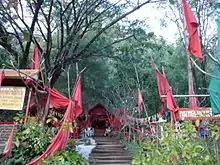台语民族民间信仰
台语民族民间信仰,又称精灵崇拜、鬼魂崇拜、秕教[1]:39、庀教[1]:24(寮語: Satsana Phi;泰語:),是台语民族的传统民间信仰总称,是带有泛灵信仰、祖先崇拜和巫觋宗教特点的多神教。台语民族主要包括泰国泰族、老挝佬族、缅甸掸族、中国傣族、印度阿洪姆人等。

泰国碧差汶府的守护神庙
_05.jpg.webp)
泰国程逸府神庙内部
在老挝,老龙族主要信仰佛教,而老听和老松两个民族集团仍然主要信仰民间宗教,因此鬼魂崇拜仍然是老挝重要的宗教信仰,信徒占老挝约30%的人口[2]。老挝佛教中亦融合了许多民间信仰的特点[3]。
台语民族的民间信仰将超自然的神灵称为秕(; phi),一般是各地的守护神,也可以是祖先的魂魄等超自然力量。这些神灵既是守护民众平安的守护之神,也可能是带来灾祸的破坏之神。寺庙的守护神称为秕洼(; phi wat),村镇的守护神称为拉勐(; lak mueang)。民众通过祭祀仪式来祭神,期间以粮食和酒作为祭品。此外,源自婆罗门教的神祇也被纳入台语民族的神系;另外一些源自本土信仰的神灵则被称为秕滕(; phi thaen)[4]。万物有灵,一些神灵和自然现象和事物有关,如天、地、水、火等。
台语民族的民间信仰认为人体中有灵气,称为“魂”或宽(; khwan),共有32种。灵气充沛者身心健康,会交到好运。因此,人在重大的人生节点前,需要举行特殊仪式,称为招魂仪式、拴线仪式或“巴西”( basi; baisi),以召回失散的灵气[5]。在欢迎宾客和归来的旅者、庆祝病患康复时也会举行招魂仪式。招魂仪式也是老挝人婚礼和起名仪式的重要环节[5]。
参见
- 老挝佛教
- 纳 (缅甸)
参考文献
- 方芸; 马树洪. . 列国志(新版) 2018年11月第2版. 北京: 社会科学文献出版社. 2018年. ISBN 9787520131698.
- Yoshihisa Shirayama, Samlane Phompida, Chushi Kuroiwa, 2006. p. 622, quote: «[...] Approximately 60 to 65% of the population, most of whom are Lao Lum (people of the lowlands) follow Buddhism. About 30% of the population, on the other hand, hold an animist belief system called "Sadsana Phee" [...]».
- . [2020-12-31]. (原始内容存档于2019-11-09).
- Poulsen, A. (2007). Childbirth and Tradition in Northeast Thailand. Copenhagen, Denmark: Nordic Institute of Asian Studies.
- Ireson, W. Randall. "Animism in Laos". A country study: Laos (页面存档备份,存于) (Andrea Matles Savada, editor). Library of Congress Federal Research Division (July 1994).
 本文含有此來源中屬於公有领域的内容。
本文含有此來源中屬於公有领域的内容。
- Yoshihisa Shirayama, Samlane Phompida, Chushi Kuroiwa. Malaria Control Alongside "Sadsana-Phee" (Animist Belief System) in Lao PDR. In: Modern Medicine and Indigenous Health Beliefs, Vol 37 No. 4 July 2006.
外部链接
- Lao Heritage Foundation: Baci Ceremony(页面存档备份,存于).
This article is issued from Wikipedia. The text is licensed under Creative Commons - Attribution - Sharealike. Additional terms may apply for the media files.